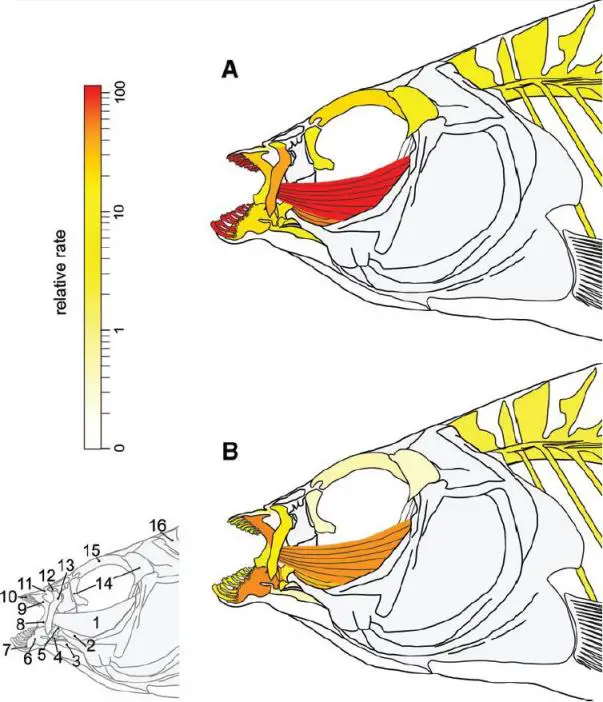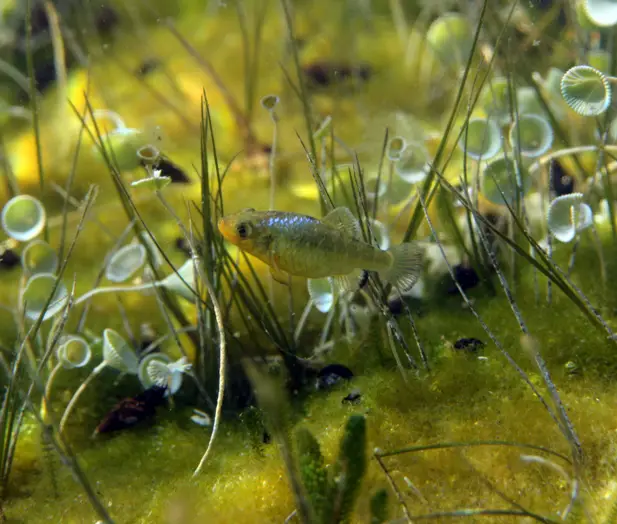Pupfish form evolutionary ‘mountain ranges’
Members of the genus Cyprinodon, often referred to collectively as ‘pupfishes’, aren’t particularly well-known in the aquarium hobby for a variety of reasons, not least that many of the 50 or so species inhabit isolated environments and are not especially easy to maintain in captivity, plus they tend to lack the gaudy colouration which has made African relatives such as Nothobranchius or Aphyosemion so popular.
They are however of great interest to conservation biologists and evolutionary scientists since many species are highly-localised in terms of distribution and tend to inhabit extreme environments, while some are notable for extremely rapid rates of evolution which are among the fastest known in the animal world.
This kind of accelerated evolution is often referred to as ‘adaptive radiation’, of which the most famous examples among fishes are perhaps the enormously diverse populations of cichlids inhabiting eastern Africa’s great lakes, home to hundreds of endemic species, some of which have developed extreme ecological specialisations such as scale-eating (lepidophagy), fry-stealing, parasite-feeding and ambush predation.
Such radiation events are typically associated with an initial increase in rates of morphological and species diversification as new ecological niches are colonised followed by a slowdown in diversification, and this theory is sometimes referred to as ‘early burst’.

Pupfish ‘heat map’ taken from Martin and Wainwright (2011). Colours indicate the rate of morphological diversification in (A) Lake Chichancanab and (B) San Salvador relative to other cyprinodontids. Numbers refer to the 16 traits measured. © Chris Martin
The precise mechanisms driving radiations have not always been clear, though, and one theory suggests that moving into a unique niche or niches may drive species to diversify more quickly than when they make a sideways movement to a similar niche in a new environment.
Chris Martin and Peter Wainwright of the University of California at Davis have been investigating these processes in two groups of sympatric Cyprinodon species which display some notable differences compared with the majority of the genus, and have for the first time been able to map peaks of fitness in a functioning evolutionary system.
Cyprinodon are distributed throughout the Caribbean and Atlantic coast of North America, and diversification among them has mostly been driven by geographic vicariance.
They inhabit a diverse range of environments, from freshwater rivers and lakes to brackish estuarine waters, isolated springs and hypersaline lagoons, but almost all of them have a diet composed of algae and organic detritus and present allopatric patterns of distribution.
The latest study was conducted on San Salvador Island, The Bahamas
Those inhabiting Lake Chichancanab in Quintana Roo state, Mexico and lakes on the island of San Salvador in the Bahamas, however, have evolved into groups of species occurring in sympatry and exploiting diverse but specific resources with some spectacular morphological adaptations.
In Chichancanab these originally included five species, among them the largest and second-smallest known in the genus, but introduction of the non-native characid Astyanax fasciatus and cichlid Oreochromis mossambicus have already driven three of them to the brink of extinction.
However, in the hypersaline lakes of San Salvador exist three undescribed Cyprinodon species in the absence of alien invaders, all of which inhabit at least two lakes on the island.
One is a generalised detrivore displaying broad similarities with C. variegatus (a widely-distributed species which appears to be the closest relative to the lake-dwelling fish), the second is a specialised predator of gastropods and ostracods and has modified jaw morphology allowing it to close its mouth with greater force and crush shells, while the third feeds on the scales of other fishes and has an elongate body and a jaw mechanism permitting a fast biting action.
The trio have been unofficially named C. sp. ‘detrivore’, C. sp. ‘durophage’ and C. sp. ‘lepidophage’.
No other pupfishes are adapted to feeding on molluscs or fish scales so the scientists’ research is focussed on whether unique mechanisms have driven the evolution of such ecological novelty and why this has occurred in just two cases across the entire Cyprinodon range.
Their first paper on the subject was published in 2011 and they were able to demonstrate that the diverse morphology in Cyprinodon spp. of Chichancanab and San Salvador had evolved at a rate of up to 131 and 51 times as fast as other cyprinodontids, respectively, and that these changes had not been driven by the amount of time the fish had been separated from congeners but by them filling unique, previously empty trophic niches.
The authors concluded that invasion of novel niches is a mechanism apparent in ‘many classic examples of adaptive radiation’.

One of the artificial enclosures in Crescent Pond, San Salvador, where field research was carried out. © Chris Martin
The precise factors driving this trophic innovation remained unclear, however, so Martin and Wainwright decided to investigate the San Salvador fish further, and their results are published in the January 2013 issue of the journal ‘Science’.
Here the fish are placed on an artificial evolutionary landscape based on the relationship between phenotype and fitness, and this can be visualised rather like a topographical map with individuals displaying greater reproductive success placed at a higher ‘altitude’ and vice versa.
A series of peaks and troughs are formed, with the fish closer to the peaks producing more offspring than those further down the slopes, thus passing on more of their genes to the next generation and ascending closer to the summit of our metaphorical mountain.
Should a range of such peaks be produced the fish at the top of each may become reproductively-isolated from one another, unable to reach adjacent mountains due to the deep valleys acting as barriers between them.
The lake systems of San Salvador are considered to be less than 10,000 years old meaning the endemic fishes represent very young species in evolutionary terms, and they retain the ability to hybridise.
Wild-caught breeding colonies of all three were therefore used to produce several thousand F2 hybrids of which 1865 individuals were measured for 16 morphological traits, fitted with coded wire tags and transported back to the island.
Once there the fish were stocked in enclosures within the respective lake from which their grandparents had been collected and left alone for 3 months, after which all survivors were recollected. Scores were assigned for survival and growth rate then compared with results obtained for pure-bred F1 fish in the laboratory at Davis.
In enclosures where the fish were stocked at high densities the highest peak was formed by hybrids resembling sp. ‘durophage’ with a second summit occupied by hybrids resembling sp. ‘detrivore’. These were separated by a deep trough at the bottom of which were the offspring more closely-related to sp. ‘lepidophage’.
The implication here is that although the detrivorous form is by far the most abundant in the natural lake systems the durophagous fish displays the greater fitness in a competitive environment, but the evolutionary ‘valley’ between them prevents the detrivorous fish from crossing to the other, higher, peak because the fittest individuals are only able to move uphill on the slope they already occupy.
In lower-density enclosures survival was higher due to reduced competition, and this result offers a glimpse of the adaptive landscape in the lakes when they first formed, trapping the ancestors of today’s Cyprinodon inside.
Rather than a complex mountain range with peaks and troughs this would perhaps have resembled flatter foothills with multiple peaks rising up quickly as different ecological niches became colonised, and this is congruous with the ‘early burst’ theory of adaptive radiation mentioned earlier.
Some peaks may not have been successfully colonised long-term, and those that remained are now separated from one another in an evolutionary sense.
The authors go on to suggest that the rarity of trophic specialists in other Cyprinodon populations might be attributed to ‘stabilising selection’ on the widespread detrivorous forms, this being a common type of natural selection in which intermediate phenoptypes are favoured and genetic diversity decreases as the population stabilises on a particular trait.
In the case of Cyprinodon, this could cause a given detrivore population to become stuck on an isolated, localised peak, and should a subpopulation manage to escape this by becoming a trophic specialist it would quickly form its own, potentially higher, peak due to its relatively greater fitness within the new niche.
Although this higher peak may represent the optimal solution in that environment, individuals of other phenotypes are unable to reach it because they’re bound to travelling ‘uphill’ within their own evolutionary lineage, and this represents a classic problem of fitness landscapes.
Empty niches may therefore be colonised quickly but when that happens it may be difficult for new specialists to become established because the resulting landscape is more difficult to move around.
None of this explains, however, why pupfish populations have diversified in this way while others in the Caribbean have not. Upon visiting similar lacustrine ecosystems on neighbouring islands in the Bahamas Martin found C. sp. ‘generalist’ and the ubiquitous Gambusia hubbsi but there are no specialist populations.
So, if not the environment, what is so special about San Salvador pupfishes that has allowed them to diversify?
This is the next question which Martin hopes to answer, and he thinks the solution may lie in their genetic diversity. His next goal is therefore to compare genetic, phenotypic, and ecological diversity across these Bahamian islands to determine what makes San Salvador unique.
For further information please refer to the full, open access paper: Martin, C. H. and P. C. Wainwright. 2013. Multiple Fitness Peaks on the Adaptive Landscape Drive Adaptive Radiation in the Wild. Science 339(6116): 208-211
NB: since this article was published C. sp. ‘lepidophage’ and C. sp. ‘durophage’ have been described as C. desquamator and C. brontotheroides, respectively, while C. sp. ‘detrivore’ has been confirmed to represent C. variegatus. For further information please click here.
Category: Articles, Science | Tags: adaptive radiation, Bahamas, Chichancanab, Cyprinodon, evolution, killifish, pupfish, trophic novelty | 6 comments »






January 22nd, 2013 at 5:27 pm
Nice! Exactly what I needed to read!
January 25th, 2013 at 6:34 pm
Yep it’s fascinating stuff and the fish are pretty cool as well. 🙂
We’re going to run a readers’ interview with Chris Martin soon so get your questions ready!
January 25th, 2013 at 7:11 pm
You know what’s really bad with articles like this??
The list of “fishes I need to keep before I kick the bucket” gets ever longer!! 🙂
January 25th, 2013 at 8:07 pm
The scale-eating one is particularly funky imo.
January 26th, 2013 at 2:37 pm
Great article indeed. I’ve been wanting to try my hand on keeping one of the Cyprinodon species for a long time and this article doesn’t exactly help, like Rüdiger pointed out 😉
January 30th, 2013 at 12:57 am
[…] through evolution to a wide variety of niches that other animals often cannot occupy. In the report “Pupfish form Evolutionary Mountain Ranges” Seriously Fish suggests the reasons for increased evolution in these very exploitive fish: They are […]